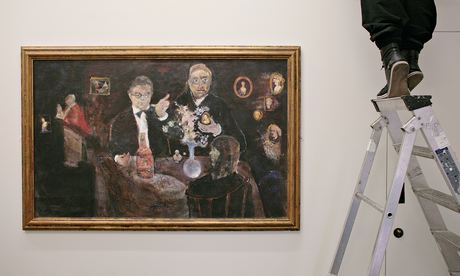
The late Beryl Bainbridge's London home was as crowded as her mind.
The novelist's house was filled not only with family and friends, life-size plaster saints, stuffed animals and a lavish collection of souvenir royal mugs, but her own paintings of characters including Samuel Johnson sitting at her dining room table teaching her Latin.
Now the first exhibition of the author's paintings since her death in 2010 will give a dizzying demonstration of the connections between an often surreal imagination – in which Napoleon might drop in to dance in a Camden town sitting room – her work and her home life.
Bainbridge, famously five times nominated but never a Booker prize winner, was also a passionate self-taught artist and the paintings covered most walls or were propped several deep against them. The subjects are as personal as the setting: children, friends and lovers, historical events, scenes from her novels including the death of Captain Oates on Scott's last Antarctic expedition, or real people in improbable settings including her mother – a collage glued to a piece of old wallpaper – singing with a grand orchestra.
Some of the most fantastical scenes came from real life: her former mother-in-law really did try to shoot her, though, as far as curator Susie Christensen can establish, Bainbridge was not naked at the time unlike in the painting.
Her family has also lent many possessions seen in the paintings – a stuffed owl under a glass dome, an oil lamp, a copper water heater, a vintage cash register, a stuffed fox, the saints. Part of the exhibition at the Inigo Rooms at Somerset House attempts to recreate a room in the house; eclectic is a pitifully inadequate description.
The house has now been sold, after her children tackled the mammoth clearance. The seven life-size plaster saints went to her daughter Jojo Davies – "nobody else wanted them," she said, slightly puzzled. She has also found space for Eric, the massive buffalo head; he proved too fragile to move to the exhibition, after decades when all visitors had to squeeze past in Bainbridge's narrow hall.
Davies is both looking forward to and dreading the exhibition, because her mother and the house are still so vivid to her. The three children are seen in tender portraits, and they remember her at work on canvases propped on the kitchen table after supper, or laid on newspaper spread out across the floor: "She didn't care, she just got stuck in, with whatever materials came to hand" her daughter recalled. "It was a very messy process."
This exhibition opens next week and has been organised by the Cultural Institute at King's College, which occupies part of the complex of palatial buildings on the Strand in London. It will bring together the largest collection of her work, though some paintings were shown in her native Liverpool in 2012 with the help of her friend Psiche Hughes.
Nobody, including the curators and the children, is quite sure how many Bainbridges there are. As a young woman she lived for a time by selling some of her earliest work. She later sold some for charity, and gave many more away: the exhibition includes some loaned by private collectors, including the novelist and critic AN Wilson.
Bainbridge had long relationships with two artists, her husband Austin Davies, who remained a friend long after their divorce, and Don McKinlay, and the co-curator Michael Regan says that although both clearly influenced her work, she had her own very distinctive style.
Archive loans are coming from the British Library, including letters, diaries and photographs, and the manuscript of Filthy Lucre, an illustrated novel published 40 years later but written when she was 13. Beryl's Last Year will also be shown, a documentary made with her grandson Charlie Russell when she was convinced she would die aged 71, like many members of her family. In fact, despite cancer, a heart attack, and a half century's epic smoking habit, she beat the odds and almost made it to her 77th birthday.
The fact that one of the best loved and most admired authors of the 20th century, nominated for novels including The Dressmaker, An Awfully Big Adventure, and According to Queeney, never won the Booker was seen by many as a scandal, and a special "Best of Beryl" prize was invented after her death. "She did care about the Booker, and so did we," Davies said. "One of us went to the ceremony with her each time, but the rest of us waited at home, all dressed up, ready for the phone call. It was devastating."
Regan thinks the paintings were also more important to her than she admitted: "She cared very much," he said, pointing to a giant canvas of Napoleon and a naked Bainbridge. "No amateur would attempt something on that scale just as a harmless hobby. She didn't hold back. This mattered to her."
• Art & Life: The Paintings of Beryl Bainbridge, Inigo Rooms, Somerset House, until 19 October

